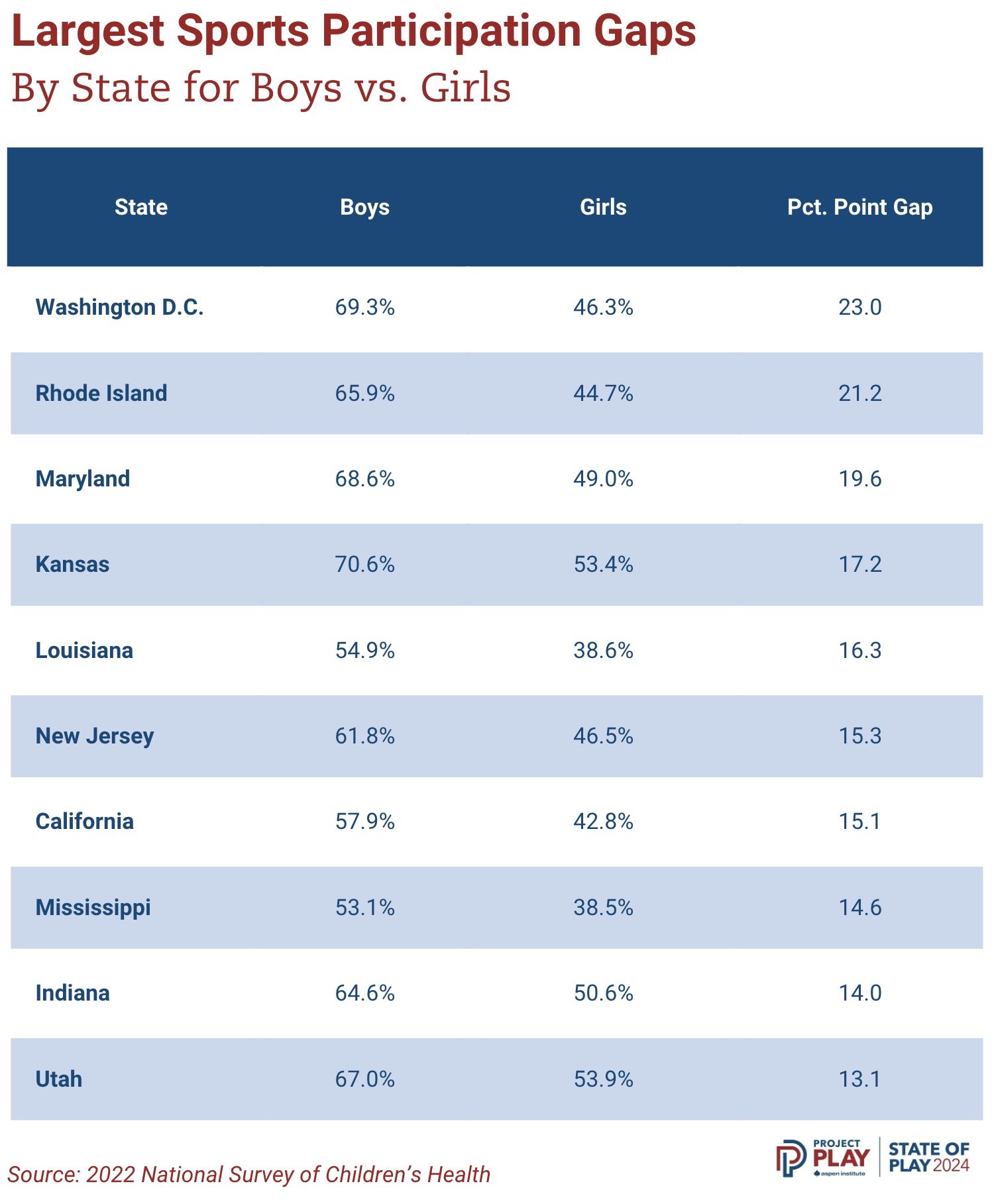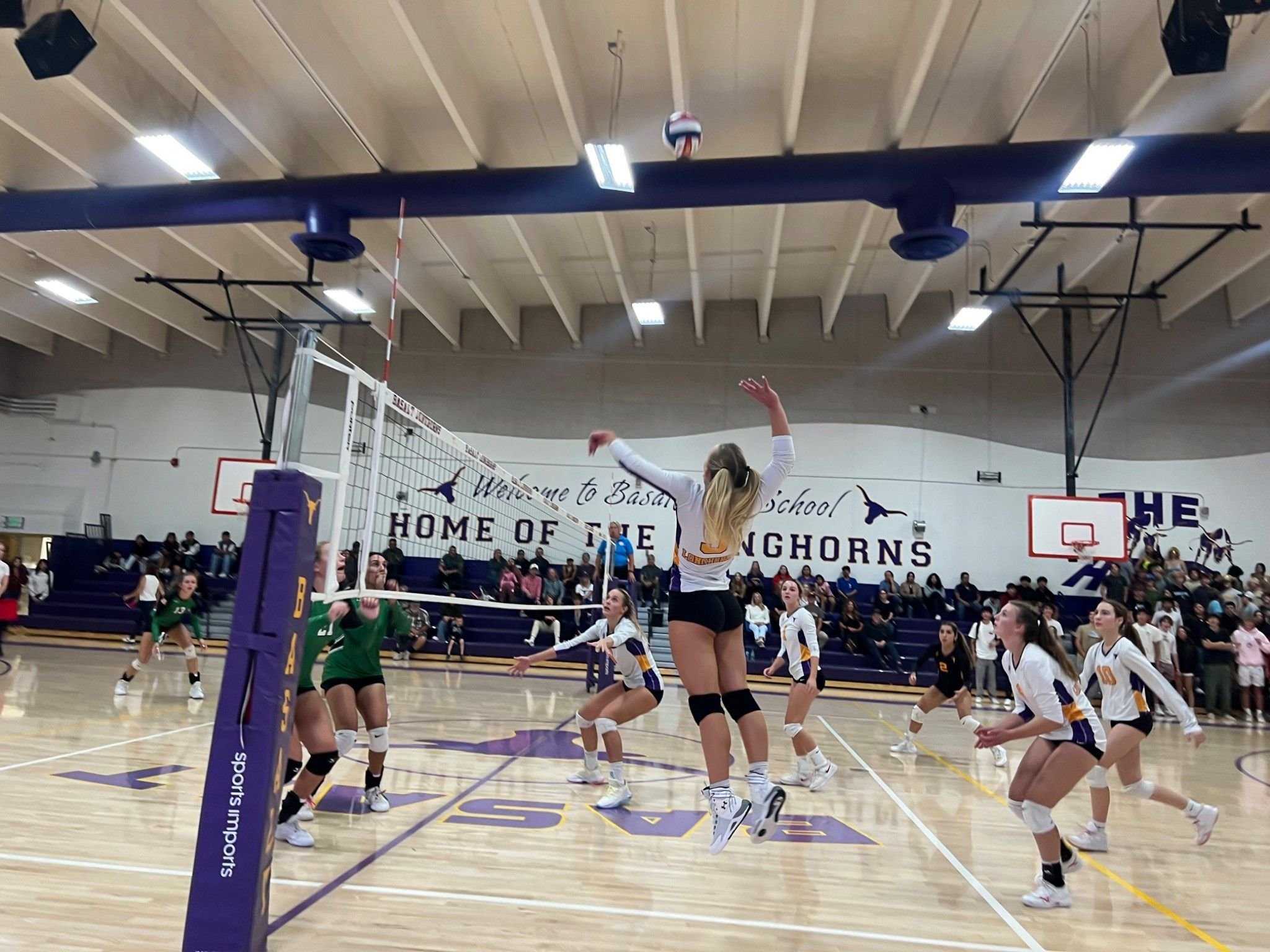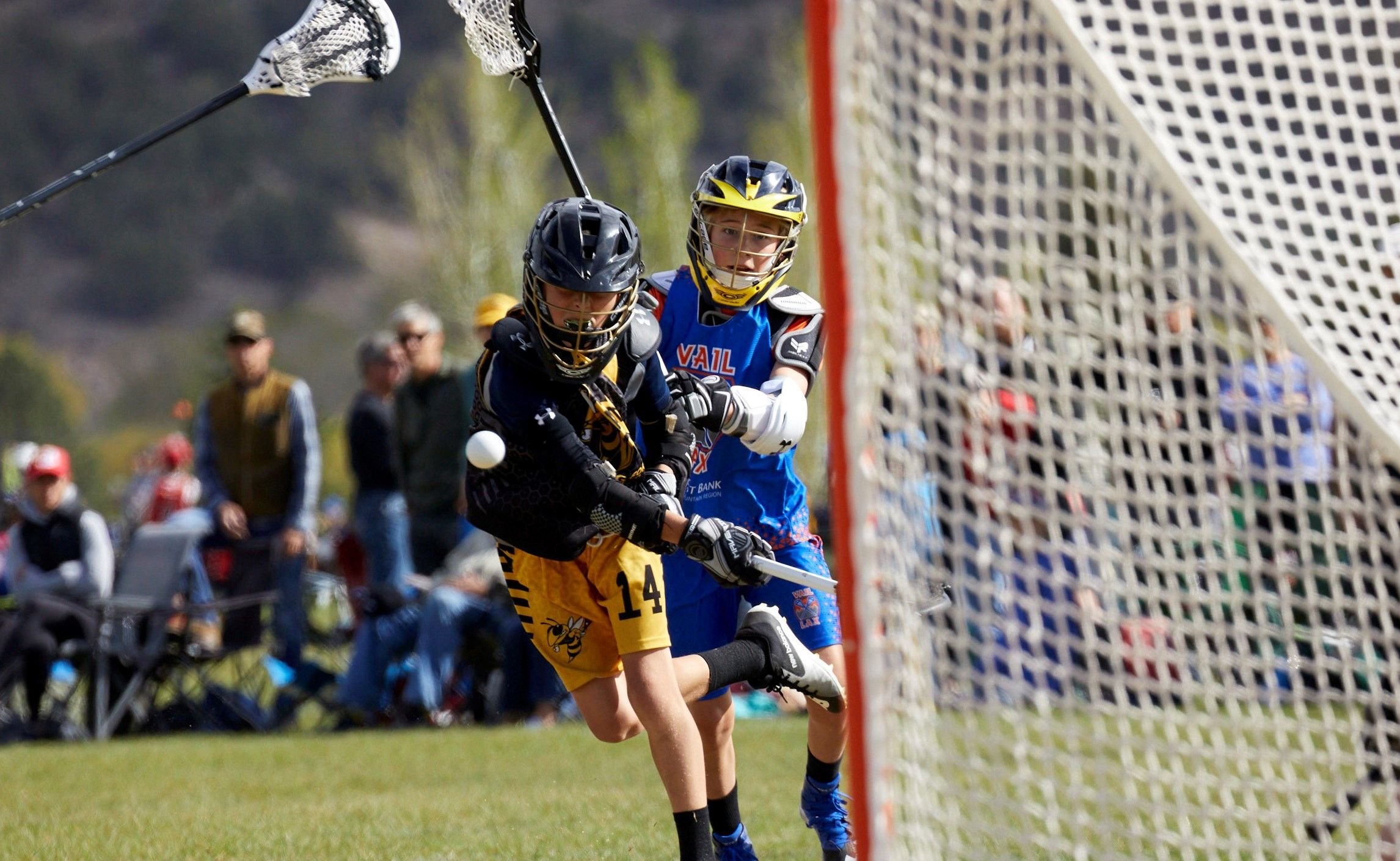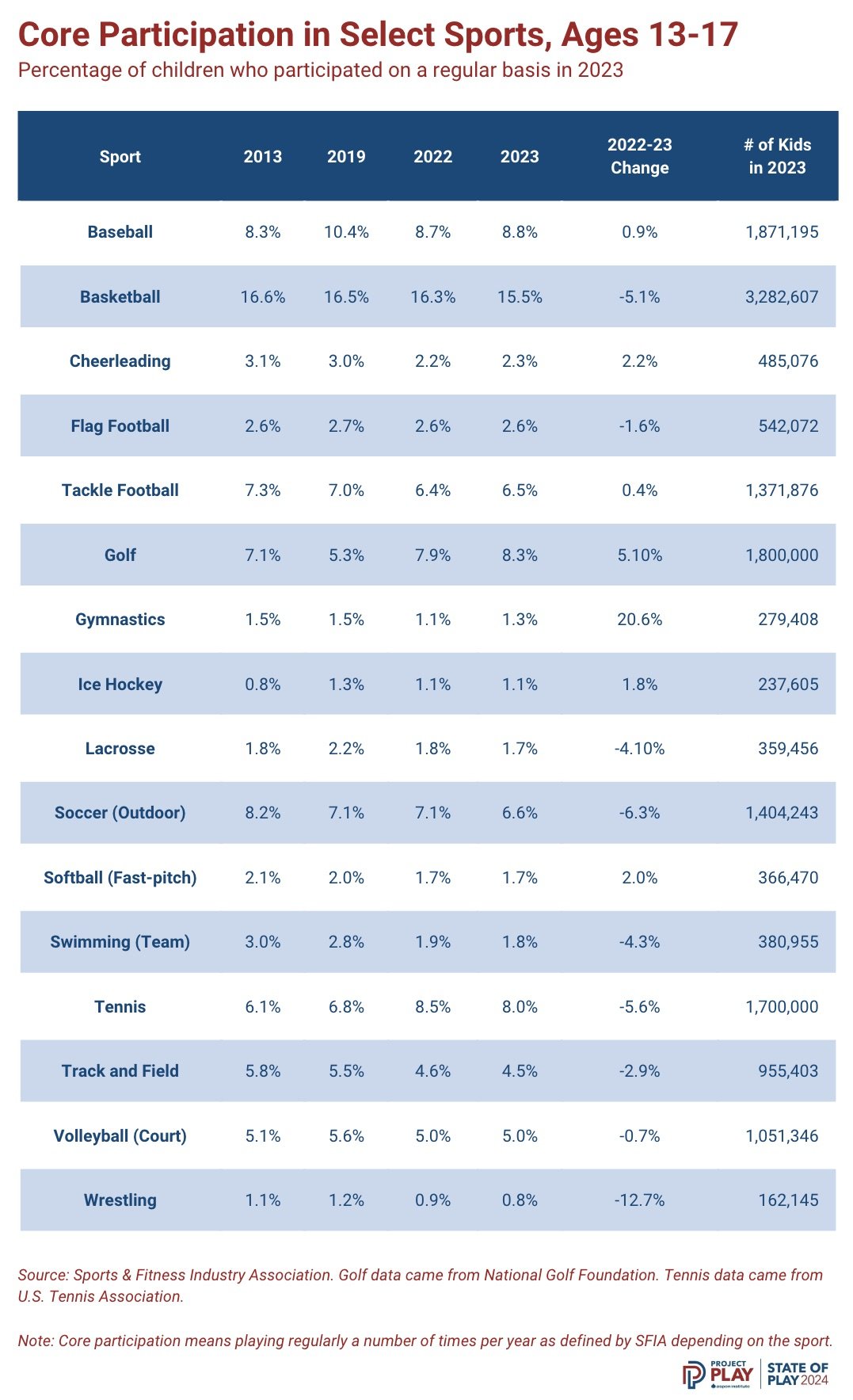Participation Trends
Sports participation is increasing – more children regularly played sports in 2023 at the highest rate since 2015. Some states have much greater participation than others. Girls participation is increasing and boys participation is significantly declining. Black children are playing sports far less than they once did. Household income continues to factor into access as early-sport specialization increases. The trends below come from the Aspen Institute’s State of Play 2024 report, informed by interviews with leaders in the youth sports space, data analyzed by the Project Play team, or articles and research produced by other entities.
Top Participation Trends
1
Vermont, Iowa and North Dakota lead the way among U.S. states for participation. The federal government has a national goal for youth sports participation to reach 63% by 2030, an effort being championed by Project Play through our 63X30 roundtable organizations. According to the most recent data from the National Survey of Children’s Health, seven states reached the 63% clip in 2022 – Vermont (69%), Iowa (68%), North Dakota (67%), Wyoming (64%), Maine (64%), South Dakota (64%) and New Hampshire (64%). All are rural in nature and less densely populated, with many high schools serving just a few hundred students, which discourages cuts to teams because coaches need to fill rosters. All have large White populations and most are relatively affluent. Another 11 states were within three percentage points of the federal government’s goal.
Hover over the map for state specific data
The 2022 national average was 54%. New Mexico had by far the lowest rate (41%), followed by Nevada (46%), Mississippi (46%) and Louisiana (47%). Except for Nevada, an anomaly due to revenues flowing through its casino and entertainment industries, all are among the poorest states in the country, with large minority populations. Children from the lowest-income homes play sports at up to half the rate of those from the highest-income group, and Black and Hispanic children, especially those from homes in which English is a second language, have among the lowest sport participation rates, according to the federal data. Another characteristic the seven states with the highest participation rates had in common: each had at least 60% female participation, easily surpassing the U.S. female average of 49%.
2
Children are returning to pre-COVID sports participation rates. In 2023, core team sports participation (meaning playing on a regular basis) reached its highest levels for all ages of children since 2015, according to data from the Sports & Fitness Industry Association (SFIA). Regular sports participation remains lower than what it was a decade ago. But coupled with the positive trend in recent years of more children trying sports at least one day over a 12-month period (total team sport participation), there is reason for some optimism. At the same time, it’s important to recognize that participation is still often dependent on demographic factors and individual interests of each child.
The bulk of the latest increase came from older youth – 594,000 more adolescents ages 13-17 regularly played sports in 2023 compared to 2022. Children ages 6-12 saw a minimal one-year increase of 58,000 more regular participants.
“The return to core team sports was driven by experiences – did you already have a passion to play and an organization?” said Tom Cove, SFIA senior advisor and former president/CEO. “Travel team sports that already had a paid coach or organization got right back to it after COVID. The difference between ages 6-12 and 13-17 is the older ones already had a system to come back to. Who’s going to be the coach of a 10-year-old rec team that hasn’t played in two years? Similarly, parks and recreation operations came back strong but they’re also struggling with many new things to do and more challenges.”
That made playing sports in 2023 most challenging for families of children ages 6-12 who come from the lowest-income homes (under $25,000). These children were the only income bracket that declined in core participation from the previous year (4% decrease); every other income bracket at that age increased between 3% and 6%.
Regular sports participation for ages 6-12 in homes earning $100,000 or more increased 6% over one year. But it declined 2% for the wealthiest youth ages 13-17 for the second straight year. The 2023 rate was the lowest since at least 2012. Adolescents from the $75,000-$99,999 income bracket played sports more frequently for two straight years than those from the $100,000 and above bracket. Historically, the wealthiest youth at this age regularly play sports more often than all other income levels.
“These are kids are often being fed sports with a fire hose,” said Tom Farrey, Aspen Institute Sports & Society Program executive director. “There is lots of pressure on them to play one sport year-round, traveling all over the place. Some are burning out or are just too injured to continue playing.”
The value of a quality sports experience aligned with the needs and interests of youth can be immense. Adults who kept playing organized sports through their youth have fewer symptoms of anxiety and depression than those who never played or those who dropped out, according to a study by Ohio State. And those who dropped out of sports had poorer mental health than those who never played at all.
While dropping out of sports was associated with poorer mental health, not all reasons for dropping out had the same effects. Interpersonal reasons for dropping out – including not having fun, not getting along with team members and being abused by a coach – were associated with adult depressive and anxiety symptoms.
Those who couldn’t afford sports and sporting equipment also showed poorer mental health. But those who dropped out in order to focus on grades actually showed lower depressive symptoms.
“Unfortunately, it is not a simple story of playing sports is good for kids,” said Chris Knoester, senior author of the study and sociology professor at Ohio State. “It is complicated by whether kids stick to playing sports and the reasons why they do stick to it or quit.”
Click image to enlarge and download
3
Fewer boys are playing sports. Not that long ago, in 2013, half of boys ages 6-17 participated regularly in sports, according to SFIA data. Only 41% of boys did in 2023. While that’s a slight increase from a year earlier, this is an ongoing and troubling trend. Boys participation has resided at 41% or lower for eight straight years.
Federal government data also shows a decline over the past decade, although not as steep. The National Survey of Children’s Health suggests that boys participation decreased from 61% in 2017 to 58% in 2022, the most recent year released. The most recent data from the CDC’s Youth Risk Behavior Surveillance System is from 2021, during the pandemic, when boys participation sat at 52%, down from 60% in 2013.
The SFIA data offers the most post-pandemic insights. It shows that in 2013, the core participation gap between boys and girls was 15.4 percentage points in favor of boys. By 2023 this gap favored boys by only 5.4 percentage points. And it keeps shrinking – as recently as 2021, boys and girls participation rates were separated by 8.2 percentage points. Boys still play sports at higher rates than girls. But the SFIA data suggests something has happened with boys over the past decade.
“That’s a significant change and it’s a mystery to me why,” Cove said. “I would speculate there’s an element to this that making teams has become really hard, and more boys can’t make the team, so they stop playing. In general, girls aren’t getting cut nearly the way boys are. My sense is youth sports have become a self-fulfilling prophecy around travel and competition, and there aren’t enough places to play when you get cut.”
Linda Flanagan, author of “Take Back the Game: How Money and Mania Are Ruining Kids’ Sports — and Why It Matters,” noted that girls are now more apt than boys to graduate from high school and college, earn higher grades and become valedictorians. “The decline in male sports participation could be one more reflection of this widespread decline in boys and men’s achievement,” Flanagan said. “We also shouldn’t discount the impact of phones, which became widely available in 2012, coinciding with the start of the teenage mental health crisis.”
In addition, the costs to play may be impacting participation rates for boys, said Karen Issokson-Silver, Women’s Sports Foundation (WSF) vice president of research and education. WSF research found that the youngest generation of surveyed women (those in their 20s) reported the highest barrier to play sports as a child due to costs. “It would not be surprising that this would show up in participation rates, and perhaps more so for boys where the cost of play could be considerably higher given a more competitive level of play available to them and the transportation, equipment and coaching costs associated with that,” Issokson-Silver said.
Girls ages 6-12 (34%) and 13-17 (38%) regularly played sports at higher levels in 2023 than in any recent year dating to at least 2012, according to SFIA. Older girls, in particular, are being added. Total team sports participation for girls 13-17 – meaning they played sports at least one day in the last year – climbed from 54% to 55% to 58% over the last three years after never being higher than 49% until 2021.
4
Black children are playing sports less than they once did, while Hispanic participation is increasing. SFIA data shows that only 35% of Black youth ages 6-17 regularly participated in sports during 2023, down from 45% in 2013, when Black children played at a higher rate than White peers. White, Hispanic and Asian American children all played sports more frequently in 2023 than Black youth.
In her book “White Sports/Black Sports: Racial Disparities in Athletic Programs,” sport sociologist Dr. Lori Martin theorized that sport participation patterns along racial lines are largely determined by opportunity structure rather than personal interests. Black youth are more likely to grow up in neighborhoods that are “sports deserts” — defined as urban and rural neighborhoods with low access to organized sport and physical activity opportunities — compared to their non-Black counterparts, Martin wrote.
“In connection to the plight of Black communities more broadly, Black youth sport involvement is integrally connected to socio-ecological conditions that are rooted in historical, political, economic, and cultural complexities,” authors of the National Black Sport Participation and Physical Activity Report wrote in 2024. “For example, despite only constituting 13.5% of the U.S. population, Black people represent 20.1% of those who live in poverty.”
Dr. Joseph Cooper, co-author of the report, said other factors could be impacting the decline in Black youth sports participation, such as the COVID pandemic, much lower participation rates by Black girls than boys, school closings, unemployment rates, health disparities, family compositions and Black youth interest in other activities like music, arts, dance, esports and multimedia. While White sports participation increased by 0.7 percentage points since 2019 prior to COVID, Black participation was down 2.5 percentage points in that period.
“It’s hard to understate the impact of COVID on the Black community,” said Cooper, director of the Sport Leadership and Administration Program at the University of Massachusetts Boston. “There was medical mistrust within communities of when it was safe to play, the opportunity structure financially to play was impacted, and a number of programs simply closed.”
In the latest SFIA data, regular sports participation by Hispanic children ages 6-12 increased 14% from 2022 to 2023, the highest since 2016. But challenges remain, especially in communities with many first-generation immigrants and in certain areas of the country. In California, just 24% of Latino/a youth played sports four times a week, half the rate of White youth, according to a report by the LA84 Foundation. Often, Latino/a children quit sports for family responsibilities.
Cove predicts there will be dramatic participation growth among Hispanic youth in the next 5-10 years as U.S. demographics continue to change, and sports providers figure out better systems to support families.
Sports providers will need to ensure free or low-cost access to all sports for Hispanic children along with quality training, said Patty Godoy, co-founder of the ELLA Sports Foundation, which empowers leadership in Latina athletes.
“The increased sports participation by Hispanic children is due to parents’ increased knowledge and understanding of the value sports provides to children, which has been a recent change in the Hispanic community,” Godoy said. “For Hispanics, investing in youth sports is now seen as an investment on social capital. Sports is seen as a vehicle to attend university and break the cycle of economic challenges and social/cultural disconformities, thus opening doors for more lucrative futures.”
In 2024, the Aspen Institute’s State of Play Aspen to Parachute report recommended using soccer as a tool for social change given the enthusiasm for the sport among Latino/a youth in the Roaring Fork and Colorado River valleys. The recommendations include offering more affordable soccer at younger ages, using the sport to chart pathways toward college, and bringing organized soccer back to the local community college.
14%
Increase in participation by Hispanic children from 2022-2023, the highest since 2016
5
Children are specializing in one sport even more after the pandemic. The average number of sports children ages 6-17 regularly played in 2023 was 1.63, down 13% since 2019, according to SFIA data. More than a decade ago, children used to average more than two sports that they played. The number started decreasing amid the increased commercialization of youth sports and pressure on families to pick one sport at younger ages. However, the average slightly increased from 2018 to 2019 until declining since then.
“We’ve got to get off this play more, pay more and the focus on every little element of development,” Cove said. “The purpose of youth sports is not to create the next Tiger Woods. It should be to provide a quality experience to the vast number of kids so they enjoy it, and part of that is winning, but not the main goal. We should be upfront about that. If we lose sight of that, we’re doing kids and families a disservice and we’re doing sport in general a disservice.”
Although core participation went up for youth ages 6-12 and 13-17 in 2023, that was mostly due to large numbers of kids from the most-played sports. Nine of the 16 sports evaluated for this report experienced lower rates in 2023 compared to a year earlier. Basketball, baseball and soccer continue to have the most participants, although soccer declined at both age levels. Below is a chart from SFIA from several years ago, but still useful in understanding challenges of retention, showing the percentage of children playing major team sports at each age.
Source: Sports & Fitness Industry Association
“Soccer is the sport that kids most often play first,” Farrey said. “But immediately, soccer starts losing them, as travel teams form and community leagues begin to wither, denying a sustained experience from late bloomers and kids whose families can’t afford the youth sports arms race. We’ve got to find a way to bring back in-town leagues.”
The good news: Parents want better and more options for their children than local sport ecosystems are offering. The LA84 Foundation survey found that two-thirds of parents (68%) say youth sports are becoming too specialized.
Tackle football for ages 6-12 increased by 4% in 2023, while flag football was up 8%. From 2019 to 2023, tackle football decreased 5% for the youngest age group as flag increased 16% and became the fastest-growing sport in the U.S. Thirteen high school state associations have sanctioned girls flag football and another 19 states are involved in pilot programs at some level.
As girls flag football grows, the sport’s leaders may want to monitor what’s happening to lacrosse. In the late 1990s and early 2000s, lacrosse was considered the fastest-growing team sport in America. The latest SFIA data shows lacrosse and wrestling have the steepest participation declines for children ages 6-12 over the past one year, three years and five years (40% decline for both sports). As lacrosse reached higher levels in recent years with kids specializing at younger ages, Cove said children who play multiple sports fell behind skill-wise in lacrosse, resulting in fewer opportunities to make teams and less joy on the field.
USA Lacrosse, the governing body of the sport in the U.S., said that while the pandemic had a major impact on youth participation, the trends shown by SFIA differ from USA Lacrosse’s data. USA Lacrosse pointed to SFIA data showing increases in casual participation and USA Lacrosse’s data reflecting youth membership growth (1.9% one-year increase in 2024 for ages 14-and-under and 34% growth for 6-and-under since 2018).
RESEARCH SOURCES
National Survey of Children’s Health (NSCH)
Through the Healthy People 2030 program, the federal government set a national target for youth sports participation of 63% by the year 2030. The data used to track this goal comes from NSCH, which provides rich data on multiple, intersecting aspects of children’s lives – including physical and mental health, access to quality health care, and the child’s family, neighborhood, school and social context. The survey is funded and directed by the Health Resources and Services Administration and Child Health Bureau. The question asked of parents that constitutes national and state-by-state sports participation rates: “During the past 12 months, did this child participate in a sports team or did they take sports lessons after school or on weekends?”
Sports & Fitness Industry Association (SFIA)
SFIA commissioned an online, nationally representative survey from Sports Marketing Surveys (SMS) that the Aspen Institute annually uses to track sports participation rates and coach training data. In 2023, the most recent year with available data, SMS conducted 18,000 online interviews with a national sample of individuals from U.S. proprietary online panels representative of the U.S. population of people ages 6 and older. Strict quotas associated with gender, age, income, region and ethnicity were followed to ensure a balanced sample. Activity reporting is based on a rolling 12-month participation rate.
Ohio State University Mental Health Study
Ohio State’s 2024 research was published in the Sociology of Sport Journal. The study used data from the National Sports and Society Survey, conducted in 2018 and 2019 with almost 4,000 adults from across the U.S. who answered questions about their sports participation as children and their current anxiety and depression symptoms. The survey showed that 35% of adults did not play organized sports at all growing up, 41% participated and dropped out, and 24% played continuously until age 18.
Youth Risk Behavior Surveillance System (YRBSS)
YRBSS, conducted by the CDC, monitors adolescent health behavior changes over time. It identifies emerging issues, and plans and evaluates programs to support youth health. One survey question asks young people if they played on at least one sports team, run by their school or community groups, during the past 12 months.


















